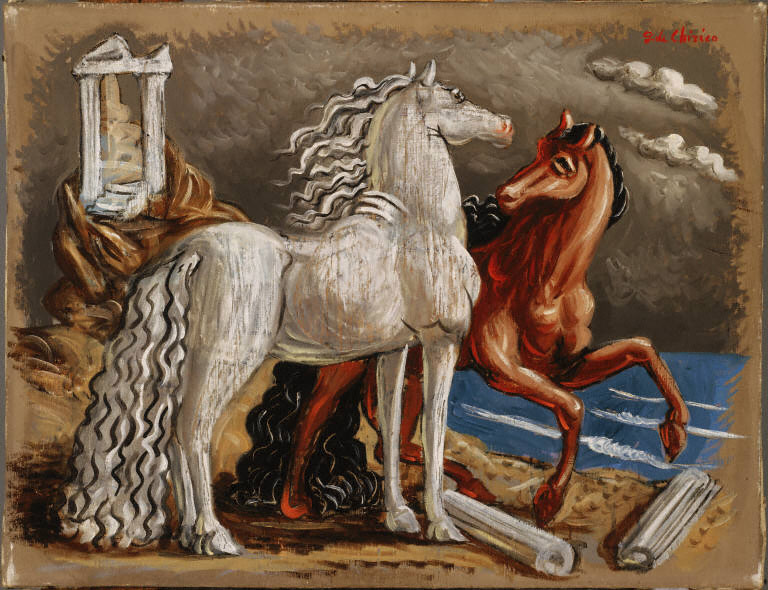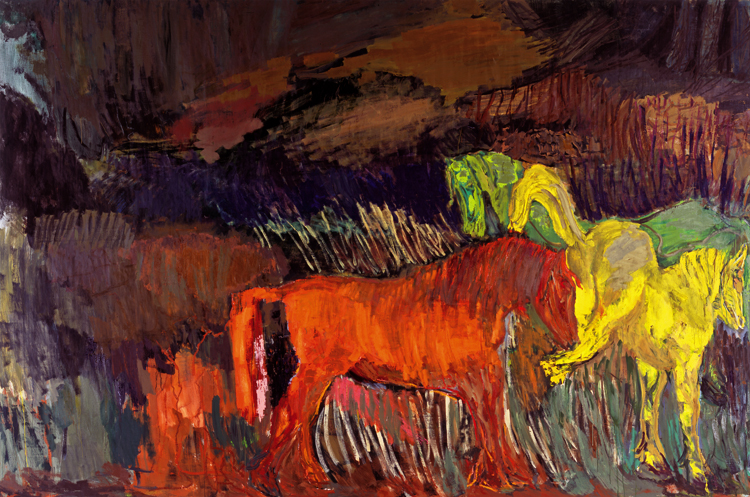As we prepared to observe the Chinese or Lunar New Year, year of the horse, we realized just how many horses we have in the collection. Lots! And so, in honor of all 15 days of the Lunar New Year festivities, we bring you 15 days of horses to start your year off right.
Tag Archives: horses
Artists in Italy: Joseph Stella and Giorgio de Chirico
Read part one in this series.

Joseph Stella, Vesuvius, c. 1915-20. Watercolor and pencil on paper, 9 1/2 x 13 1/4 in. (24.1 x 33.7 cm). The Phillips Collection, Washington, D.C., Gift of Jennifer and Alan Pensler in memory of Leslie Pensler, 1997.
Born near Naples, Italy in 1877, the artist Joseph Stella moved to the United States at the age of 18 where he began a career in medicine before attending the Art Students League in New York to study painting. He traveled to Paris in 1909, was inspired by cubism and futurism, and later participated in the Armory Show of 1913. He continued to experiment with styles, the result of which can be seen in the vibrant colors of his watercolor Vesuvius from between 1920 and 1940, shown above. Italian Landscape, also from this time period, shows softer colors and more subtle references to modern techniques.
While born to Italian parents, Giorgio de Chirico grew up in Volos, Greece, and studied art in Athens, Italy, and Germany. As an adult, de Chirico lived in many cities throughout Italy, each leaving its mark on his work. The painting seen below, Horses (1928), depicts two horses on a beach standing before a Roman architectural structure that refers to the legacy of Italian culture.
Drew Lash, Curatorial Intern
Wild Horses (Couldn’t Drag Me Away)
The largest of Per Kirkeby’s paintings in our current exhibition—Untitled (2009)–is a favorite of many visitors. In an interview with Director Dorothy Kosinski, Kirkeby said:
I took the horses not from any kind of photos but from the famous works by Baldung Grien, who has four or five very fantastic woodcuts. So that’s a kind of borrowed structure. Woodcuts are very clearly defined with lines. So from them I got a starting point. One of my sons gave me a birthday gift of a big beautiful book full of pictures of horses. I dare not say it, but what am I going to do with that? I don’t need a real horse. I need the lines that pretend to be a horse.
Hans Baldung Grien was a German Renaissance painter and a prolific printmaker. He was a student of Albrecht Dürer. Grien produced three woodcuts of wild horses, each print not much bigger than a sheet of letter-size paper. Kirkeby probably chose his three horses from a herd in Grien’s Stallion and Kicking Mare with Wild Horses (1534).

Hans Baldung Grien (Germany, Schwäbischgmünd (?), 1484 – 1545), Stallion and Kicking Mare with Wild Horses, 1534. Print, Woodcut, Sheet: 9 x 13 1/8 in. Los Angeles County Museum of Art
What about the colors he chose for the three horses–red, yellow, and green? The light yellow and spring green shows up in many of Kirkeby’s paintings throughout the years, almost like a signature; perhaps they are the hopeful colors of spring after a long Danish winter. Maybe they suggest the colors of autumn, as Kirkeby has written in his book Isolation of Parts: “Yellow – red and green are the most crucial of colors. Green is the surface until the plants yield to desert yellow and red.” Chlorophyll yields to xanthophyll and anthocyanin. Or perhaps he has a distant memory of a 100-year-old painting by Franz Marc of three cows, in which a yellow one kicks up its heels with a red and a green companion.

Franz Marc, Cows, Yellow-Red-Green, 1912. Oil on canvas, 24.4 x 34.4 in. Staedtische Galerie im Lenbachhaus, Germany.
Kirkeby’s medium for this horse painting is unusual: tempera on canvas. Although he is rather coy about his technique, he has written:
Move from oils and that hazardous turpentine to water-soluble paints, break down what is wooly and impasto. A more fluid, drier character emerges. From the same material in terms of content. . . . I am now intending to switch to water-soluble paints and protect my brain from turpentine-induced decay. That is my choice, and it is perhaps one that in the same way as other choices of such ‘technical’ nature will lead to something new. A new and unexpected turn.
In this case, his use of tempera led to horses.
Ianthe Gergel, Museum Assistant



